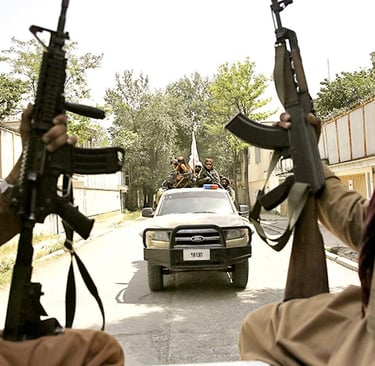Pakistan-Afghanistan Conflict 2025: Between Borders, Blood, & Broken Promises
WARTOP 10 OF THE DAYWORLD
10/12/20253 min read


SOURCE : THE HINDU
Along the 2,600-kilometre stretch of the Durand Line, where rugged mountains give way to dusty plains, a long-standing tension has erupted into open hostilities. What began as cross-border skirmishes between Pakistan and Afghanistan in recent years has turned into a conflict alive with human cost, political complexity, and uncertainty over what comes next.
1. Seeds of Escalation
The current wave of conflict cannot be understood without tracing its roots:
Tehreek-e-Taliban Pakistan (TTP): Pakistan accuses the Afghan Taliban government of providing safe-havens and logistical support to the TTP, a militant group conducting frequent attacks inside Pakistan. This accusation has repeatedly featured in recent years as a key trigger for Pakistani security operations. Dawn+2IAS EXPRESS+2
Border Disputes & The Durand Line: The Durand Line — the colonial-era border that divides Pashtun communities — remains emotionally and politically contentious. While Pakistan considers it the internationally recognized border, many in Afghanistan do not formally accept it. That fault line has deep cultural, tribal, and political consequences. Al Jazeera+2Wikipedia+2
Broken Trust & Diplomacy: Repeated cycles of accusation, retaliation, and military action have eroded trust. Diplomatic relations have been downgraded and later partially restored. Border crossings have been shut, trade disrupted, and communities made vulnerable. Scfr+2Reuters+2
2. What Happened Recently (2025 Escalation)
Here are recent events that show how the conflict has sharpened lately:
Around 9 October 2025, Pakistan reportedly conducted airstrikes in major Afghan locations (Kabul, Khost, Jalalabad, Paktika) targeting Noor Wali Mehsud, the TTP leader. Mehsud survived the attack. Wikipedia+2AP News+2
In response, Afghan Taliban forces struck Pakistani military posts along the border during night operations (11-12 October), including in Kurram, and captured some posts according to Taliban claims. Pakistan claimed to have destroyed several Afghan posts in contrast. AP News+3Wikipedia+3Reuters+3
Casualty counts are disputed: Afghanistan claims many more Pakistani soldiers were killed than Pakistan accepts. The exact dead / wounded figures vary, depending on sources. AP News+2The Guardian+2
Key border crossings (Torkham, Chaman, Kharlachi, Angoor Adda, Ghulam Khan) were closed. These closures disrupt trade, movement of people, and supply chains, affecting civilians especially. Reuters+1
3. Human Stories & Costs
Beyond official statements and military claims, the human dimension is deep and painful:
Families living along the border face anxiety of sudden bombardment, cross-fire, and displacement. Farms, schools, clinics in remote border villages are particularly vulnerable.
Refugees and migrants are caught in the crossfire both physically and legally: many Afghans with expired permits in Pakistan have been forced to return amid fears and uncertainty. AP News+1
Economic disruption hurts people more than governments: traders, transporters, workers who depend on cross-border trade are losing livelihoods. Border closures don’t just close gates; they close doors to income and stability.
4. Stakes & Perspectives
The motivations and fears of each side are layered, and none are simple:
Pakistan’s view: Security first. Deny TTP sanctuaries, protect its regions from infiltration, prevent attacks. Pakistan sees its military operations as necessary, even if risky.
Afghanistan’s/Taliban’s view: Sovereignty and non-interference. While being accused of harboring militants, Kabul rejects violations of its territory and demands mutual respect. Also, pressure from inside to assert control and respond to perceived encroachments.
Regional ripple effects: Other countries are watching — China, Iran, Saudi Arabia. Supply lines, aid, trade, geopolitics involved. Militancy, refugee flows, border stability: all become regional issues.
5. What Must Change: Paths Toward De-escalation
To prevent further bloodshed, both immediate and structural changes are needed:
Transparent Dialogue: Establish neutral monitors along the border; share intelligence about militant movements so misunderstandings don’t escalate.
Controlled Use of Force: Commit to limiting airstrikes and heavy artillery in border zones inhabited by civilians; avoid collateral damage.
Humanitarian Measures: Ensure refugees and displaced people are protected, have access to aid, education, and health. Restore legal status or regularize stay where possible.
Economic & Border Cooperation: Reopen border crossings, facilitate trade, easing hardship. Shared infrastructure, customs cooperation, roads, and health access can build trust.
Third-Party Mediation: Trusted international or regional actors (e.g. UN, neighbouring states) could broker temporary ceasefires, help verify claims, and ease tensions.
6. Looking Ahead
If the current trends persist:
Escalation could spread: more attacks, heavier weapon use, damage to infrastructure.
Civilian suffering may increase: more displacement, school closures, health crises.
Trust will erode further, making diplomacy harder.
But conversely: there is space for positive change — if both governments prioritize human security over displays of force, the precarious balance might shift toward peace.
Conclusion
This conflict is not just about posts taken or lost, or statements issued. It is about people—villagers torn between borders, families afraid of raids, economies interrupted, young children missing school. Both sides carry national grievances, fears, and obligations. Violence only deepens the wounds.
For peace to matter, it must begin with recognition: that human lives—regardless of side—count, and that no victory at the border can mean anything without safety and dignity for those who live there.
---------------- READ MORE ----------------
Updates
Stay informed with the latest worldwide news.
Connect
© 2024. All rights reserved.
